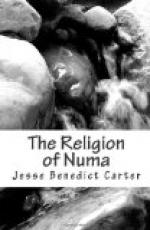the other by imperceptible gradations, but the influence
of Etruria on Rome not only led to nothing but was
in itself of a most superficial sort. Etruria
must have had some literature, yet we search the history
of Roman literature in vain for any traces of the influence
of that literature on Rome, with the one exception
of books on divination and the interpretation of lightning.
We know too little of her manners and customs to be
able to tell exactly how much they may have influenced
Rome, and yet it is worth noting that the things which
Roman writers actually refer to Etruria, are all of
them most superficial: a few of the insignia
of political office; a few of the trappings of one
or two ritualistic acts; a branch of divination, by
the consultation of the entrails (haruspicina),
which was of secondary importance compared to augury;
and the most depraved form of Roman public sport, the
gladiatorial games. The only fundamental institution
of Rome which it is the habit to ascribe to Etruria,
the idea of the so-called templum or division
of the sky into regions as an axiom of augury, seems
to have been quite as much a general Italic idea as
a specifically Etruscan one. Even in art her
influence was relatively slight, and though her architects
seem to have built the earliest formal temples for
Rome, they were soon succeeded in this work by the
Greeks. We seek in vain for a complete and satisfactory
explanation of this limitation of her influence, but
certain thoughts suggest themselves, which, as far
as they go, are probably correct. All that we
know of Etruria impresses us with the fact that hers
was an outward civilisation unaccompanied by an inward
culture, that it was a formal rather than a spiritual
growth, an artificial acquisition from without rather
than a development from within outwards. It was
strong but with its strength went brutality, it was
interested in art but for its sensual rather than its
spiritual aspects. Now the idealism of youth
is present in nations just as in individuals, though
probably a nation is less conscious of it than an
individual. It is with the nation one of the effects
of the instinct of self-preservation, and for a youthful
nation to absorb the vices of an old decadent one
would be self-destruction. Thus the youthful Rome
rejected most of the Etruscan poison, and thus nature
purified herself, and Etruria was buried in the pit
of her own nastiness.
There was however one town which acted as an interpreter between Rome and Etruria, and was the original cult-centre for a very great goddess, spreading her cult in both directions, into Rome and into Etruria. The town was Falerii and the goddess was Minerva, who in a certain sense entered Rome three times, once direct from Falerii to Rome, and once from Falerii to Rome by way of Etruria, and finally, when Falerii was captured by the Romans, again direct to Rome. In the earliest period there are scarcely any traces of the worship of Minerva




